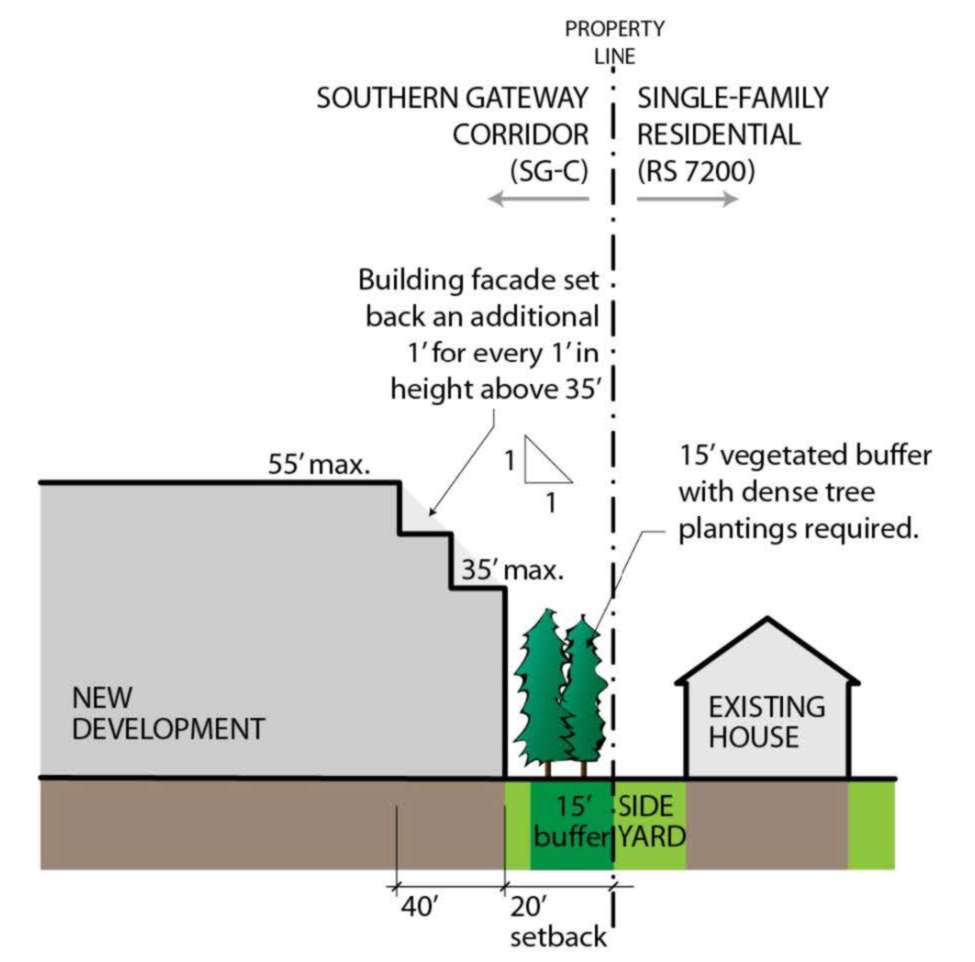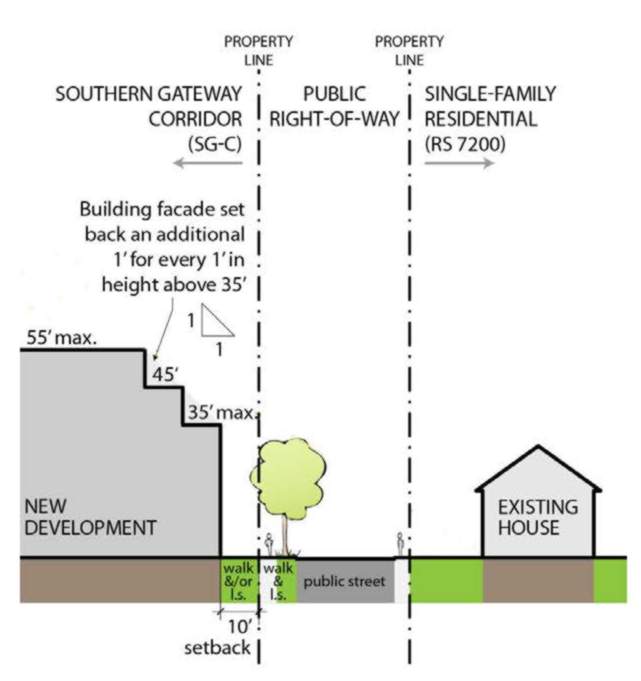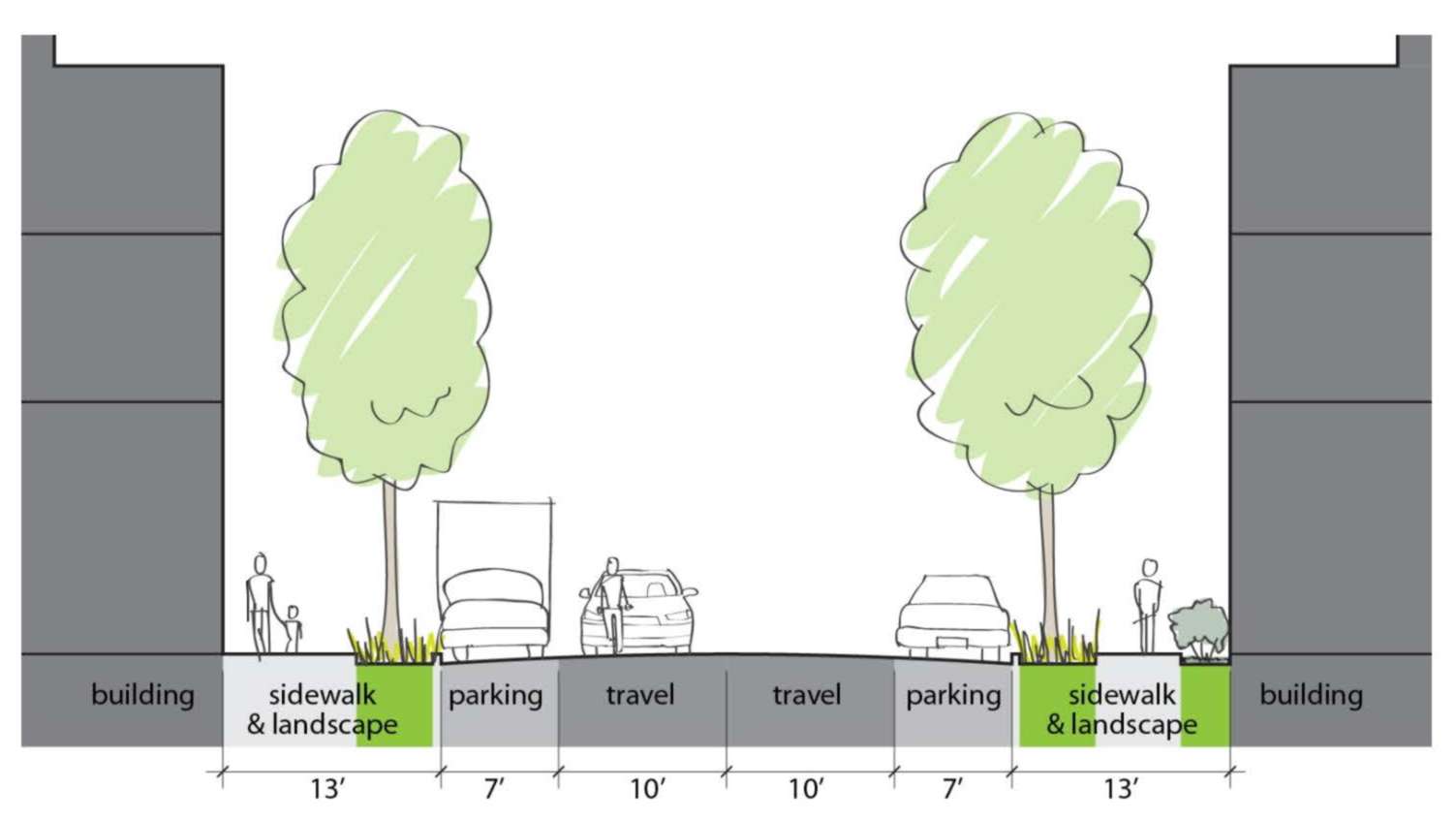Chapter 18.46
SG-C SOUTHERN GATEWAY – CORRIDOR
Sections:
18.46.020 Permitted uses – Commercial and nonresidential.
18.46.030 Permitted uses – Primary and accessory residential.
18.46.090 Screening and landscaping.
18.46.110 Parking requirements and traffic impact mitigation.
18.46.130 Southern gateway – corridor and transition zones design guidelines – Application – Effect.
18.46.140 Setbacks and north-south access road requirement.
18.46.160 Bonds or other financial security.
18.46.010 Purpose.
The intent of the SG-C zone is to:
A. Encourage neighborhood and community scale residential and commercial uses which provide services to the local community, a greater range of economic opportunities, a pleasant residential environment and a focus for the local community.
B. Support an active, walkable mixed use center.
C. Create an attractive gateway and streetscape character.
D. Improve the intersections along Bothell Way and local vehicular and pedestrian circulation.
E. Protect the livability and attractiveness of residential neighborhoods.
F. Implement the city’s environmental sustainability objectives. (Ord. 1057 § 2, 2013)
18.46.020 Permitted uses – Commercial and nonresidential.
The following commercial and nonresidential uses are permitted in the SG-C zone, subject to other general provisions as set forth in this title, except where modified by this chapter:
A. Retail Sales of Food and Commodities, Which Involve Only Incidental and Limited Fabrication and Assembly. Uses excluded from this zone would include auto service stations, sale of gasoline or other fuels, car washes, and repair or sale of heavy equipment, boats, tires and motor vehicles.
B. Business offices and uses rendering professional, personal, and instructional services, such as real estate or insurance brokerages, consultants, medical or dental clinics, technical training, health clubs, and repair of jewelry, eyeglasses, clothing, household appliances and tools, or other such similar uses; excluding vehicle or tool rentals, outdoor pet sales and housing (kennels).
C. Marijuana retailers licensed by the state of Washington Liquor Control Board and as defined in Chapter 18.08 LFPMC.
D. Government and institutional buildings and uses, including but not limited to police stations, schools, educational facilities, libraries, administrative offices, and other public service uses that are compatible with the intent of the SG-C zone.
E. Day care facilities.
F. Public utilities.
G. Adult use establishments; provided, however, that the operation of an adult use establishment shall be prohibited within 660 feet of any residential zone; and provided further, that adult use establishments shall not be operated concurrently within 660 feet of, nor within the same structure as, the operation of any other adult use establishment; and provided further, that no adult use establishment shall be located within 660 feet of schools, licensed day care centers, public parks, community centers or public libraries or churches which conduct religious or educational classes for minors. (Ord. 1095 § 11, 2015; Ord. 1057 § 2, 2013)
18.46.030 Permitted uses – Primary and accessory residential.
The following residential uses are permitted in the SG-C zone, subject to general provisions as set forth in this title, except where modified by this chapter:
A. Multiple dwelling units.
B. Senior citizen apartments.
C. Convalescent, nursing and retirement homes. (Ord. 1057 § 2, 2013)
18.46.040 Limitations on use.
Every use locating in the SG-C zone shall be subject to the following further conditions and limitations:
A. Residential uses are not permitted as separate projects; they must be developed in combination with commercial or nonresidential uses as part of a single site development plan.
B. Business and residential portions of a building must be separated by soundproof walls, floors, equipment, utilities or other suitable architectural features or appurtenances.
C. All businesses, services, repair, processing, storage or merchandise displays shall be conducted wholly within an enclosed building except for the following:
1. Off-street parking or loading.
2. Storage and sale of goods in connection with an established use under the provisions of a temporary use permit or special event.
3. Merchandise displays which are located in the SG-C zone where proper provision has been made for screening and safe pedestrian and vehicular passage.
4. Small outdoor display areas, not more than 100 square feet in footprint, associated with permanent indoor retail establishments; provided, that the merchandise is brought inside when the business is not open.
5. Outdoor eating and drinking areas that do not require permanent construction and are associated with permanent indoor establishments. (Ord. 1057 § 2, 2013)
18.46.050 Conditional uses.
A. Drive-through window services.
B. Individual commercial and nonresidential uses shall contain a maximum of no more than 60,000 square feet in building footprint area (as measured on the ground) per use. Uses greater than 60,000 square feet in building footprint area (as measured on the ground) and not more than 100,000 are only permitted after obtaining a conditional use permit (Chapter 18.54 LFPMC).
C. Transit facilities such as park-and-ride and kiss-and-ride lots. (Ord. 1057 § 2, 2013)
18.46.060 Building height.
A. The maximum building height limit in the SG-C zone, except for properties located between NE 145th Street and NE 147th Street, shall not exceed 55 feet. Additionally, for structures near properties zoned single-family residential (including the SG-SFR zone), the maximum height shall not exceed 35 feet plus one foot in height for every one foot more than 20 feet (measured horizontally) away from the property zoned single-family residential, up to a maximum height of 55 feet (i.e., maximum height = 35 feet + distance of portion of the structure from the SFR zone minus 20 feet).

Figure 18.46.060-1. Maximum height of buildings near a single-family zone. This figure also illustrates the landscape screen called for in LGPMC 18.46.070.

Figure 18.46.060-2. Maximum height of buildings across the street from a single-family zone.
B. For structures directly across the street from properties zoned single-family residential (including the SG-SFR zone), the maximum height shall not exceed 35 feet plus one foot in height for every one foot more than 10 feet (measured horizontally) away from the street right-of-way, up to a maximum height of 55 feet (i.e., maximum height = 35 feet + distance of portion of the structure from the SFR zone minus 10 feet).
C. Buildings on properties located between NE 145th Street and NE 147th Street shall not exceed 55 feet except as noted in subsection E of this section. Additionally, for structures directly adjacent to properties zoned single-family residential (including the SG-SFR zone), the maximum height shall not exceed 35 feet plus one foot in height for every one foot more than 20 feet (measured horizontally) away from the property zoned single-family residential, up to a maximum of 75 feet in height (i.e., maximum height = 35 feet + distance of portion of the structure from the SFR zone minus 20 feet).
D. For structures located between NE 145th Street and NE 147th Street and directly across the street from properties zoned single-family residential (including the SG-SFR zone), the maximum height shall not exceed 35 feet plus one foot in height for every one foot more than 10 feet (measured horizontally) away from the public right-of-way, up to a maximum 75 feet in height (i.e., maximum height = 35 feet + distance of portion of the structure from the SFR zone minus 10 feet).
E. Buildings on properties located between NE 145th Street and NE 147th Street may be up to 75 feet in height above grade; provided, that the restrictions noted in subsections C and D of this section are met and all of the following features or conditions are provided:
1. A public open space equivalent to two percent of the project site area and meeting the provisions of southern gateway – corridor and transition zones design guidelines for pedestrian open space is provided. This space must be in addition to the space otherwise required by the design guidelines.
2. The building is set back at least 20 feet from the 12-foot setback required by LFPMC 18.46.070 for Bothell Way NE right-of-way and a Type I or Type II vegetated screen meeting the requirements of the southern gateway – corridor and transition zones design guidelines is planted along the building face. If the building features a pedestrian-oriented facade facing at least 75 percent of the building facade facing Bothell Way, then the city may relax requirement for the landscaping of the buffer.
3. For structures located between NE 145th Street and NE 147th Street and directly across the street from properties zoned SG – transition, the maximum height shall not exceed 55 feet plus one foot in height for every one foot more than 10 feet (measured horizontally) away from the public right-of-way on the boundary between SG – transition and SG – corridor, up to a maximum 75 feet in height. (Ord. 1057 § 2, 2013)
18.46.070 Setbacks.
Minimum setback requirements in the SG-C zone shall be:
A. No front yard is required facing Bothell Way except that all buildings and structures and other site features along a public right-of-way must be set back from the curb to allow a 12-foot-wide strip for a combination of sidewalk and street landscaping and, between NE 145th Street and NE 147th Street, an additional eight-foot-wide strip for a landscaped buffer. The eight-foot landscaped buffer must be Type I, II or III landscaping noted in Section C.3.1, Landscape types, of the SG – corridor and transition design guidelines and as approved by the city. If the building features a pedestrian-oriented facade facing at least 75 percent of the building facade facing Bothell Way, then the city may relax requirement for the landscaping of the buffer. See also southern gateway – corridor and transition zones design guidelines. Buildings facing single-family residential zones, without pedestrian-oriented facades as defined in the corridor and transition zones design guidelines, must be set back at least eight feet from the public right-of-way to reduce visual impact to nearby residences (see Figure 18.46.060-2);
B. No side yards are required except at least a 10-foot building setback along property lines directly adjacent to a single-family residential zone (including the SG-SFR zone); and
C. No rear yards are required except at least a 20-foot building setback along property lines directly adjacent to a single-family residential zone (including the SG-SFR zone). (Ord. 1057 § 2, 2013)
18.46.080 Land coverage.
A. No maximum land coverage requirements, provided other provisions of this title, including stormwater management and open space requirements, are met.
B. All new development in the SG-C zone between NE 145th Street and NE 147th Street shall have at least a 0.5 floor area ratio (FAR). The FAR shall be calculated by dividing the “floor area” by the “lot area” as those terms are defined in Chapter 18.08 LFPMC, except that for the purpose of this provision, structured parking and indoor vehicle areas may be included in the calculation of “floor area.” (Ord. 1057 § 2, 2013)
18.46.090 Screening and landscaping.
All sites in the SG-C zone must have adequate screening and landscaping, subject to the southern gateway – corridor design guidelines. The provisions of Chapter 16.14 LFPMC (Tree Canopy Preservation and Enhancement) shall apply; provided, that the canopy coverage goal established in LFPMC 16.14.080(A) shall be five percent for the SG-C zone for nonparking areas and 30 percent for open parking lots. Also, the provisions under LFPMC 16.14.080(B) regarding designating a tree tract equal to five percent of the gross project area shall not apply. (Ord. 1057 § 2, 2013)
18.46.100 Signs.
Signs are limited to those provided for in Chapter 18.52 LFPMC and the southern gateway – corridor design guidelines. (Ord. 1057 § 2, 2013)
18.46.110 Parking requirements and traffic impact mitigation.
A. All parking in the southern gateway – corridor shall be provided in accordance with the following:
1. Provide one stall for every 250 square feet of commercial space.
2. Provide 1.25 stalls for every dwelling unit. Where the total quota results in a fraction, the next highest full unit shall be provided.
3. The applicant may apply for a parking reduction for conditions that reduce the actual parking need such as joint use, special populations, etc. The code administrator may allow a parking reduction if it is justified by a parking occupancy analysis prepared by a licensed transportation planner with special qualifications in parking analysis.
B. The applicant shall submit to the city a traffic and parking impact analysis identifying the increases in traffic and off-site parking demand. The analysis shall be prepared by a licensed professional transportation engineer. The applicant shall be responsible for implementing both on-site and off-site mitigation measures that the code administrator determines necessary to prevent significant adverse impacts to transportation systems and the surrounding area. Specifically, necessary mitigation measures, such as on-site and off-site traffic calming measures, must be taken to prevent cut-through traffic and additional parking demand on streets in the surrounding area. (Ord. 1057 § 2, 2013)
18.46.120 Southern gateway – corridor and transition zones design guidelines – Adopted – Rules of interpretation.
The Lake Forest Park “Southern Gateway – Corridor and Transition Zones Design Guidelines,” dated March 28, 2013, are adopted as the guidelines applicable in the southern gateway – corridor and transition zones and incorporated by reference herein. (Ord. 1057 § 2, 2013)
18.46.130 Southern gateway – corridor and transition zones design guidelines – Application – Effect.
Except as otherwise provided, any person who plans to develop or redevelop within the southern gateway – corridor zone shall apply to have the proposed project processed and reviewed according to this title. An accepted application shall be reviewed under the southern gateway – corridor and transition zone design guidelines, which shall take precedence over and supersede any conflicting provision of this title, including provisions incorporated by reference into this title. (Ord. 1057 § 2, 2013)
18.46.140 Setbacks and north-south access road requirement.
Where reasonably necessary to mitigate impacts disclosed by the traffic analysis prepared pursuant to LFPMC 18.46.110(B), the city’s review thereof and/or the environmental review process, approval of development in the SG-C zone between NE 145th Street and NE 147th Street may be conditioned upon construction of a commensurate portion of a north-south access street where the subject property overlaps or abuts the planned alignment of such street and where the proposed development is of a nature that the code administrator finds that this requirement is reasonable in light of the development’s impacts. The street will run north and south generally along the eastern edge of the SG-C zone. The street will be approximately 60 feet wide from backside of sidewalk to backside of sidewalk (see Figure 18.46.140-1). The roadway design must be submitted to the city for approval. In the absence of other direction from the code administrator, the roadway will generally consist of two 10-foot-wide travel lanes, two seven-foot-wide parking lanes (or widened sidewalks) and two 13-foot-wide sidewalks plus planting areas. (Sidewalks plus planting strips together must be at least 13 feet wide.)

Figure 18.46.140-1. Preliminary N-S access street section.
(Ord. 1057 § 2, 2013)
18.46.150 Administration.
The provisions of this chapter and the southern gateway – corridor and transition zones design guidelines shall be administered via a commercial site development permit (CSDP) issued pursuant to Chapter 18.48 LFPMC, as follows:
A. If the proposed development is: (1) less than 30,000 square feet in total building footprint, and (2) less than 45,000 square feet in total property area, and (3) involves only one building, and (4) does not involve phased development (over more than two years), the CSDP shall be decided upon by the code administrator as a Type III administrative decision under LFPMC 16.26.030(C), 16.26.180 and 16.26.190.
B. If the project is: (1) more than 30,000 square feet in total building footprint, or (2) more than 45,000 square feet in total property area, or (3) involves more than one building, or (4) involves phased development (over more than two years), the code administrator shall make a recommendation on the CSDP as provided in LFPMC 16.26.080, Type I applications – Code administrator’s recommendation, and the procedures for a hearing examiner decision stated in LFPMC 16.26.090 through 16.26.110 shall apply. (Ord. 1057 § 2, 2013)
18.46.160 Bonds or other financial security.
The city may require a bond or other financial security to ensure compliance with any aspect of a permit or approval under this chapter. (Ord. 1057 § 2, 2013)


